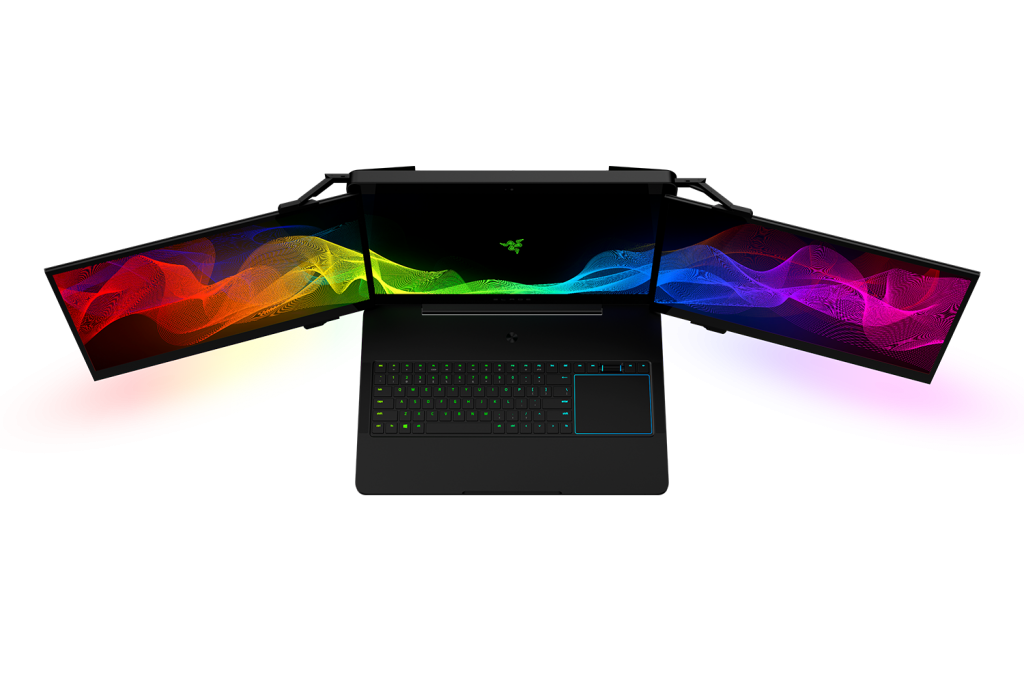Share This
Related Posts
Tags
Project Valerie
By Leah Etling on Feb 19, 2017 in Technology
CES in Las Vegas was yet again a groundbreaking tech event, but aside from self-driving cars, next-gen TV’s , drones and virtual reality, there was one item that made waves —Razer’s Project Valerie. A couple of years have passed since the PC gaming peripheral brand brought something bold to CES (Project Christine in 2014), but this year the company went all out and unveiled the world’s first automated triple-display laptop.
, drones and virtual reality, there was one item that made waves —Razer’s Project Valerie. A couple of years have passed since the PC gaming peripheral brand brought something bold to CES (Project Christine in 2014), but this year the company went all out and unveiled the world’s first automated triple-display laptop.
Founded in 1998, the innovative tech company once only known for its gaming accessories, like keyboards and mice, has quickly become an industry leader with its Blade series laptops, and Razer Edition PC’s. The newest addition to the Razer family, Project Valerie, which is just a prototype as of now, is quite different from any other laptop currently on the market.
The firm showcased the device at CES and it was available for testing as well. In fact, it attracted so much attention, that two of the laptops were actually stolen and later popped up in China, listed for around $22,000, but I’ll get to that in a minute. First, let’s see Valerie’s specifications.
Besides the three obvious screens, each 17.3-inch wide with 4K displays, making the laptop actually 12K (I know, right?), Project Valerie weighs approximately 12 pounds and is 1.5 inches thick. It boasts lighting strips under the two side monitors, a low-profile mechanical LED keyboard which features 16.8 million colors with vibrant lighting effects, and a touch pad and roller on the right side of the device.
At its core, Project Valerie features the top-of-the-line Nvidia GeForce GTX 1080 graphics card and Intel’s 6th generation i7-6700HQ quad-core processor. Since it is a concept design, the rest of the specifications and battery life have not yet been released. Moreover, the price tag and release date are unknown as well, but it is safe to say that the product will not be for the pockets of average consumers.
It is no secret that Razer’s experimental model is designed for gaming, but with specs like these, you can pretty much do anything from work to play, video editing and rendering and so on. All things considered, Project Valerie is surprisingly slim, but it is definitely a more unusual than practical option, especially if you plan to commute and travel frequently with it.
Coming back to the theft, on January 8th, two Project Valerie prototypes were stolen from Razer’s CES booth. The company has reported the theft to the police and is even offering a $25,000 reward for any information leading up to an arrest. Supposedly whoever stole the laptops somehow managed to get them out of the United States, apparently to China, where they listed them for the amount I mentioned above.
Obviously after getting some attention from the media, the listing was quickly deleted, either because the units were sold, or maybe the person who listed it got scared, or simply because the announcement was fake. As of now, it is unclear whether the police have any leads and Razer hasn’t released a statement, aside from the one right after the theft, regarding the investigation.
Razer isn’t the only one experimenting with triple-display laptops. Belgian start-up company Slidenjoy is already shipping the world’s first accessory which triples your laptop screen. Slidenjoy is available for all laptop sizes and brands, and the screens, which can be turned 180 degrees, can be connected to with a single USB. There is also an alternative to Project Valerie as well, the Razer Blade Pro. It doesn’t have the two additional screens, but it has the same hardware you’ll find in Razer’s prototype. And with Slidenjoy, you can essentially build your own Project Valerie. Hmm…
